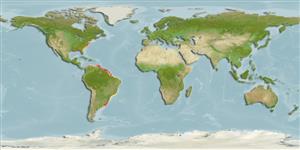klasifikasi / Names
Nama-nama umum | Sinonim (persamaan) | Catalog of Fishes(Marga, Jenis) | ITIS | CoL | WoRMS | Cloffa
>
Scombriformes (Mackerels) >
Stromateidae (Butterfishes)
Etymology: Peprilus: Greek, peprilos, paprax, certain fish from Tracia.
Environment: milieu / climate zone / depth range / distribution range
Ekologi
laut; payau; kisaran kedalaman 13 - 136 m (Ref. 116249). Tropical
Western Atlantic: French Guiana and Argentina
Size / Weight / umur
Maturity: Lm ? range ? - ? cm
Max length : 22.0 cm TL jantan/; (Ref. 124480); Berat maksimum terpublikasi: 66.80 g (Ref. 118626)
deskripsi pendek
Morfologi | Morfometrik
Duri punggung (Keseluruhan (total)): 3 - 5; duri punggung lunak (Keseluruhan (total)): 39-45; Duri dubur 3-4; Sirip dubur lunak: 36 - 41; vertebrata, bertulang belakang: 28 - 29. This species is distinguished from its congeners (except P. xanthurus) by having the following characters: precaudal vertebrae 11?12 (vs. 13 or more, rarely 12); total vertebrae 28?29 (vs. 30 or more in P. medius, P. ovatus, P. simillimus and P. snyderi); body height 58.5?79.0% SL (vs. 33.0?52.% SL in P. burti, P. simillimus, P. snyderi, P. ovatus and P. triacanthus); without series of pores along the front half of body under the dorsal fin (vs. 17?25 in P. triacanthus); a moderately falcate dorsal fin (vs. not falcate in P. triacanthus, or conspicuously falcate in P. paru); specimens larger than 9.0 cm SL, has an extremely falcate anal fin (vs. not falcate or moderately falcate in P. burti, P. simillimus, P. snyderi, P. ovatus and P. triacanthus); further distinguished from sympatric P. xanthurus by the lack of a conspicuous dark spot over the eyes, from snout to nape (vs. a conspicuous dark spot over the eyes, especially distinct in fresh specimens); in specimens smaller than 11.0 cm SL, orbital diameter is 1.6?5.0 in anal-fin height (vs. 5.1?8.0); in specimens larger than 10.9 cm SL, orbital diameter is 3.2?5.2 in anal-fin height (vs. 5.5?9.2), 2.9?3.8 in pectoral-fin height (vs. 3.9?5.9), and 0.8?1.4 in post-orbital length (vs. 1.5?2.3); further distinguished from P. paru by having a moderately long to short dorsal fin and relatively long caudal fin lobe, with length of lower lobe more than 1.2 times the length of the dorsal fin (vs. 1.2 times the length or less) (Ref. 116249).
Occurs in estuarine and coastal marine waters at depths of up to 136 meters. Probably does not form large schools for though it is common in the catches of artisanal fisheries (notably in Brazil), it is always in small numbers (Ref. 116249).
Life cycle and mating behavior
Kematangan | Reproduksi, perkembang biakan | Pemijahan | telur-telur | Fecundity | Larva
Marceniuk, A.P., R. Caires and R. Siccha-Ramirez, 2016. Review of the harvestfishes, genus Peprilus (Perciformes: Stromateidae), of the Atlantic coast of South America. Zootaxa 4098(2):311-332. (Ref. 116249)
Status IUCN Red List (Ref. 130435)
ancaman kepada manusia
Harmless
penggunaan manusia
informasi lanjut
Nama-nama umumSinonim (persamaan)metabolismePemangsaEkotoksikologiReproduksi, perkembang biakanKematanganPemijahanSpawning aggregationFecunditytelur-telurpekembangan telor
AcuanBudidaya airprofil budidaya airStrainGenetikaElectrophoresesDiturunkanPenyakit-penyakitPengolahanNutrientsMass conversion
mitraGambarStamps, Coins Misc.Suara-suaraCiguateraKecepatanTipe renangArea insangOtolithsOtakPenglihatan / visi
Alat, peralatan
laporan khas
muat turun XML
Sumber internet
Estimates based on models
Phylogenetic diversity index (Ref.
82804): PD
50 = 0.5020 [Uniqueness, from 0.5 = low to 2.0 = high].
Bayesian length-weight: a=0.01622 (0.00965 - 0.02725), b=2.93 (2.79 - 3.07), in cm total length, based on LWR estimates for this species & Genus-body shape (Ref.
93245).
Trophic level (Ref.
69278): 3.9 ±0.2 se; based on size and trophs of closest relatives
Daya lenting (Ref.
120179): Tinggi, Waktu penggandaan populasi minimum kurang dari 15 bulan (Preliminary K or Fecundity.).
Fishing Vulnerability (Ref.
59153): Low vulnerability (12 of 100).
